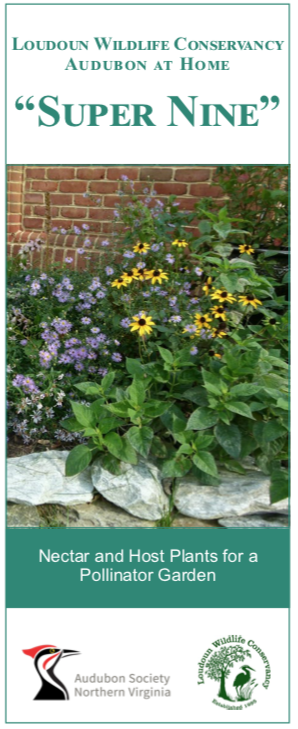Volume 24 Issue 3, Summer 2019
by Anne Owen, Coordinator, Audubon at Home Program
General awareness is growing of the crisis facing our native pollinator insects and butterflies, and the knock-on effects for our environment. Encouragingly, more homeowners are becoming interested in replacing sterile, traditional landscaping with native plants that can nourish and support these critical members of our ecosystems.
 As interest has grown, so has the amount of great educational material out there, accessible through the internet as well as through concerned organizations such as Loudoun Wildlife Conservancy and the Plant NOVA Natives Campaign. Here in Loudoun County we are also fortunate to have ready access to several native plant nurseries where we can be assured of buying pesticide-free plants and receiving excellent advice. For those of us just trying to get started, it sometimes can seem that there is just too much information out there! How to make sense of it all and choose a few reliable plants to get started?
As interest has grown, so has the amount of great educational material out there, accessible through the internet as well as through concerned organizations such as Loudoun Wildlife Conservancy and the Plant NOVA Natives Campaign. Here in Loudoun County we are also fortunate to have ready access to several native plant nurseries where we can be assured of buying pesticide-free plants and receiving excellent advice. For those of us just trying to get started, it sometimes can seem that there is just too much information out there! How to make sense of it all and choose a few reliable plants to get started?
Audubon at Home’s Ann Garvey took the lead last year to identify the absolute top picks for plants to support pollinators, native bees and butterflies here in Loudoun County, and with support from Sheila Ferguson, our brochure “Super 9” Nectar and Host Plants for a Pollinator Garden has been published.
The plants were selected to provide nectar for pollinators from spring through to fall. They are all tolerant of a range of growing conditions, so will do well in most yards in the county and are widely available at our native plant nurseries and native plant sales.
To start your pollinator garden, we suggest:
• Choose a location that will get summer sun for six hours per day or more. This is where the insects will be most active.
• Depending on your space and budget, select at least one plant to flower in each season and get advice from your native plant nursery about which varieties will be best for you as some may be smaller and more compact than others.
• Plant in groups of three together at the spacing recommended by the nursery. Insects will find a cluster of plants more readily than a single one. Tall plants go at the back, with shorter plants in front.
• In dry weather, water once a day for the first week, then once per week for a month after planting. After that, water only if you see them wilting.
• Add a small dish of water or bird bath and keep the water clean. Water is essential for all our wildlife.
• Native plants don’t need fertilizer.
• In the first year, your pollinator garden may look a little sparse and you may need to put down mulch to suppress weeds. Even when the plants are small, however, the insects will start to come! Once the plants are established, they will quickly spread and fill in the gaps depending on the type of plants.
• Leave the seed heads and dried stems standing through the winter. Birds like Goldfinches will appreciate the seeds, and some of our native bees will overwinter in the hollow stems.
Once you have some thriving plants and are enjoying the visiting wildlife, you will most likely feel motivated to try some new things. We recommend that you “graduate” to Plant NOVA Native’s fully color-illustrated guide, Native Plants for Northern Virginia, which is supported by an extensive website (plantnovanatives.org). There you will find information about many more plants that are native to our region and suitable for garden cultivation. There are also suggestions for common issues, such as deer browse, erosion control, and ground cover.
You could also consider contacting Audubon at Home for an at-home visit. We are not landscape designers, but we can provide suggestions for enhancing your property as wildlife habitat. If you meet the criteria for habitat features and the number of sanctuary species that you have recorded, we can certify your property as an Audubon at Home Wildlife Sanctuary.
References:
Loudoun Wildlife Conservancy / Audubon at Home’s “Super 9” brochure.

